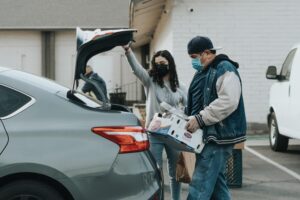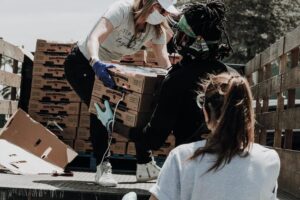As America ramps up vaccination efforts, and tens of millions of Americans are now vaccinated, the eagerness to return to normalcy is palpable. Yet, the COVID-19 pandemic has exposed and exacerbated the vast inequalities that exist in economic security, safe housing, education, and access to food and healthcare for Black, Indigenous, and People of Color (BIPOC), and low-income communities. BIPOC communities disproportionately represent the essential workforce in healthcare facilities, farms, factories, warehouses, food services, grocery stores, and elsewhere (Alobuia et al., 2020). From the start of this pandemic in 2019 to its uncontrolled spread in America and around the globe in March 2020, key data findings revealed:
- Individuals in BIPOC communities are more likely to live in areas with high rates of new COVID-19 infections (Millett et al., 2020).
- Areas with higher social and economic inequities had higher rates of infection compared with areas with lower social and economic inequities (Lewis et al., 2020).
- As of July 20, 2020, hospitalization rates and death rates per 10,000, were 24.6 and 5.6 for Black patients, 30.4 and 5.6 for Hispanic patients, 15.9 and 4.3 for Asian Patients, and 7.4 and 2.3 for White patients, respectively (Rubin-Miller et al., 2020).
- Race/ethnicity is only known for approximately 55% of those who have been vaccinated, among this group, 63% were white, 9% Hispanic, 6% Black, 5% Asian, 2% American Indian or Alaska Native, and <1% were Native Hawaiian (Ndugga et al., 2021).
 The aforementioned data does not just exist in the silo of the COVID-19 pandemic, but rather as a combination of systemic issues that continue to plague America. Before the pandemic began, BIPOC communities were already disadvantaged, with disproportionate disease mortality and morbidity rates, unequal pay for equal work, and limited access to equitable education and healthcare. These disparities are not new, but rather a reflection of what has been brewing in America for hundreds of years. The COVID-19 pandemic has been the catalyst for renewed conversation about health and race disparities in America. Beyond COVID-19 legislation, new policies need to be adopted aimed at addressing the underlying issues to combat inequities.
The aforementioned data does not just exist in the silo of the COVID-19 pandemic, but rather as a combination of systemic issues that continue to plague America. Before the pandemic began, BIPOC communities were already disadvantaged, with disproportionate disease mortality and morbidity rates, unequal pay for equal work, and limited access to equitable education and healthcare. These disparities are not new, but rather a reflection of what has been brewing in America for hundreds of years. The COVID-19 pandemic has been the catalyst for renewed conversation about health and race disparities in America. Beyond COVID-19 legislation, new policies need to be adopted aimed at addressing the underlying issues to combat inequities.
Build Healthy Places Network and Shift Health Accelerator recently published Healthy Neighborhood Investments Policy Scan and Strategy Menu, which systematically outlines key policy action and strategies that community leaders and multi-sector coalitions can take to ensure that everyone who resides in America lives a healthy and thriving life, while pointedly addressing the structural racism that exists in the many facets of our society. The Policy scan provides strategies for the following vital conditions, defined as the properties of places and institutions that everyone depends on to reach their potential (CDC Foundation and Well Being Trust 2020):
- Belonging and civic muscle
- Thriving natural world
- Basic needs for health and safety
- Humane housing
- Meaningful work and wealth
- Lifelong learning
- Reliable transportation
 Community and policy leaders throughout the nation were asked to identify a key vital condition from the Thriving Together Springboard that could advance race and health equity; “Belonging and Civic muscle” was identified as that key vital condition. “Belonging and civic muscle” highlights the need to ensure that equitable decision-making must include all voices, especially those most impacted by the decisions. Engagement from community members means that voices are being heard and decision-making power is being brokered. Though actions for each community may look different, participation in voting must be is a key pillar of belonging and civic muscle as outlined in the Thriving Together: A Springboard for Equitable Recovery and resilience in Communities Across America. As stated by Joshua Clark, political participation analyst at the Othering & Belonging Institute, in Civic Engagement for Empowering and Belonging, voter turnout is not just a function of individual choice or voter interest. It is about the socio-political systems and structures, and where and for who they confer a sense of civic belonging. From here the foundation of “Belonging and Civic” muscle can grow.
Community and policy leaders throughout the nation were asked to identify a key vital condition from the Thriving Together Springboard that could advance race and health equity; “Belonging and Civic muscle” was identified as that key vital condition. “Belonging and civic muscle” highlights the need to ensure that equitable decision-making must include all voices, especially those most impacted by the decisions. Engagement from community members means that voices are being heard and decision-making power is being brokered. Though actions for each community may look different, participation in voting must be is a key pillar of belonging and civic muscle as outlined in the Thriving Together: A Springboard for Equitable Recovery and resilience in Communities Across America. As stated by Joshua Clark, political participation analyst at the Othering & Belonging Institute, in Civic Engagement for Empowering and Belonging, voter turnout is not just a function of individual choice or voter interest. It is about the socio-political systems and structures, and where and for who they confer a sense of civic belonging. From here the foundation of “Belonging and Civic” muscle can grow.
Investing in our BIPOC and low-income communities means that all American communities can flourish. Collectively, we must thrive to obtain equity. “Without equity, we cannot end COVID-19, HIV, or any other pandemic” (Peter Sands, Global Fund 2020). The following are some actions that can be taken to increase social equity:
- Commit to leadership development. The City of Orland’s iLead program provides resources, tools, and training for community leaders to shape local public policy which is critical for supporting community-led change.
- Improve intergovernment and interagency coordination. Six cities and Solano County, California, created the Community Action Partnership Solano Joint Powers Authority to provide community services to residents to reduce poverty and homelessness. Often coordination starts with the mayor’s leadership and an ongoing commitment from department staff to work together beyond solving a specific problem.
- Utilize “The Policy Treasure Map”, in the Policy Scan, which outlines a way for multi-sector partnerships to navigate the policy ecosystem and identify common areas of policy to work on together to advance race and health equity.
Though we often hear about the desire to return to a normal pre-pandemic America, we must take this lesson from the COVID-19 pandemic and grow. Ed Yong, a writer for The Atlantic, stated in August of 2020, “… normal led to this. To avert the future pandemics we know are coming, we must grapple with all the ways normal failed us.”
About the Author
 Zachary D. Travis is a Randall Lewis Health and Policy Fellow with Build Healthy Places Network. He is currently a doctoral and master’s in public health candidate at Loma Linda University School of Medicine and California Baptist University College of Health Science, respectively.
Zachary D. Travis is a Randall Lewis Health and Policy Fellow with Build Healthy Places Network. He is currently a doctoral and master’s in public health candidate at Loma Linda University School of Medicine and California Baptist University College of Health Science, respectively.
References
Alobuia, W. M., Dalva-Baird, N. P., Forrester, J. D., Bendavid, E., Bhattacharya, J., & Kebebew, E. (2020). Racial disparities in knowledge, attitudes and practices related to COVID-19 in the USA. Journal of public health, 42(3), 470-478.
Lewis, N. M., Friedrichs, M., Wagstaff, S., Sage, K., LaCross, N., Bui, D., … & Dunn, A. (2020). Disparities in COVID-19 incidence, hospitalizations, and testing, by area-level deprivation—Utah, March 3–July 9, 2020. Morbidity and Mortality Weekly Report, 69(38), 1369.
Millett, G. A., Jones, A. T., Benkeser, D., Baral, S., Mercer, L., Beyrer, C., … & Sullivan, P. S. (2020). Assessing differential impacts of COVID-19 on black communities. Annals of epidemiology, 47, 37-44.
Yehia, B. R., Winegar, A., Fogel, R., Fakih, M., Ottenbacher, A., Jesser, C., … & Cacchione, J. (2020). Association of race with mortality among patients hospitalized with coronavirus disease 2019 (COVID-19) at 92 US hospitals. JAMA network open, 3(8), e2018039-e2018039.
Latest Data on COVID-19 Vaccinations Race/Ethnicity. Ndugga et al., 2021.